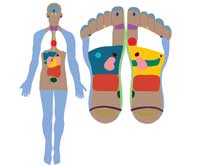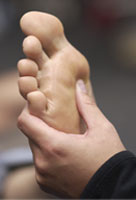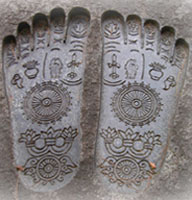Reflexology
Reflexology was introduced to the United States in 1913 by William H. Fitzgerald, M.D. (1872–1942), an ear, nose, and throat specialist, and Dr. Edwin Bowers. Fitzgerald claimed that applying pressure had an anesthetic effect on other areas of the body.
Reflexology was modified in the 1930s and 1940s by Eunice D. Ingham (1889–1974), a nurse and physiotherapist. Ingham claimed that the feet and hands were especially sensitive, and mapped the entire body into "reflexes" on the feet renaming "zone therapy" to reflexology.Ingham's theories are prominent in the United States and United Kingdom, although modern methods also exist.
Practices resembling reflexology may have existed in previous historical periods. Although its origins are not well documented, there are reliefs on the walls of a Sixth Dynasty Egyptian tomb (c. 2450 B.C.) that depict two seated men receiving massage on their hands and feet.
In the book Medicina Libri octo, Aulus Cornelius Celsus, influenced by Hippocrates writes, "Much more often, however, some other part is to be rubbed than that which is the seat of the pain; and especially when we want to withdraw material from the head or trunk, and therefore rub the arms and legs." This reference leads to the conclusion that reflexology is Greek in origin
- "A natural healing art based on the principle that there are reflexes in the feet, hands and ears and their referral areas within zone related areas, which correspond to every part, gland and organ of the body. Through application of pressure on these reflexes without the use of tools, crèmes or lotions, the feet being the primary area of application, reflexology relieves tension, improves circulation and helps promote the natural function of the related areas of the body."
Reflexologists posit that the blockage of an energy field, invisible life force, or Qi, can prevent healing. Another tenet of reflexology is the belief that practitioners can relieve stress and pain in other parts of the body through the manipulation of the feet. One claimed explanation is that the pressure received in the feet may send signals that 'balance' the nervous system or release chemicals such as endorphins that reduce stress and pain. These hypotheses are rejected by the general medical community, who cite a lack of scientific evidence and the well-tested germ theory of disease.
Common criticisms of reflexology are the lack of evidence for its claimed effects, or of a scientific or demonstrated basis for its theories, of central regulation, accreditation and licensing, or of medical training provided to reflexologists, and the short duration of training programmes. As with other pseudosciences without any proven effect beyond placebo, if patients rely on them and delay or even reject effective medical treatment there can be significant health risks.
Reflexology's claim to manipulate energy (Qi) has been highly controversial, as there is no scientific evidence for the existence of life energy (Qi), 'energy balance', 'crystalline structures,' or 'pathways' in the body.
REITERATIVE REFLEXOLOGY FOOT CHARTThis reiterative picture of the reflexes is said to be a reflection of the human body upon the plantar and dorsal aspect of the feet, hands and ears. This reflective mirror image of the bones, muscles and organs is the outgrowth of Zone Therapy as originally taught by the USA pioneers ... Drs. William Fitzgerald, Joseph Riley, Eunice Ingham, Clement Wittman and many others dating back to the early 1900'.
Freelance Reflexologist Doug Cross of Collinsville,
Mississippi demonstrates thumb-walk technique
that helped restore him back to good health.
This was done in conjunction with
Ehret's Mucusless Diet Healing System.
His nonstop self-help sessions sometimes
lasted eight hours or more a day. Here he
works on his spine as shown
on Bernardin's chart.

Each point on the foot, hand or ear was always associated with the body parts within the Zone of its alignment. Fitzgerald identified ten Zones which followed parallel lines vertically through the body. Hence a reflex in the Zone of a specific finger or toe would affect any organ or tissue group within that Zone from the toe all the way to the brain.. This was the system taught by Eunice Ingham Stopfel across the USA and learned by her student Zachary Brinkerhoff back in 1967.

"Reflexology meridians connect all the organs and glands in the body and culminate in the feet and hands. By applying pressure with the fingers or a blunt object with approximately 10-15 lbs. of force you may send a surge of energy to the corresponding area. Pressure may be applied for as long or with as much force as is comfortable,"stated Dr. Saran.
A good question has been raised by skeptics regarding the vast variation of specific point locations. "If these charts are accurate representation of the body ... then how can there be five divergent points for the heart reflex?"
Seventy years ago the medical anatomy charts were likewise very divergent in their organ location. If a surgeon was asked about this contradiction he would point out that any of the charts might be the correct one, depending on the individual patient. Imagine a heart on the right side instead of the left? This deviation has occurred as have other organs within the abdominal cavity.

The Feet of Vishnu reflect images that show the influence
of reflex stimulus covering every phase of life: political,
religious, familial, social and personal.
Eventually the medical people got together in an effort to coordinate the human anatomy charts for the sake of their credibility. The result? Individual anatomy will still differ from the standardized charts and this observation is just an accepted reality among medical professionals. Likewise, if reflexology schools got together and made one standardized chart, there would always be exceptions to the rule of formal reflex point location.

Foot Worker in India removes crystal formations from
the plantar aspect of the foot by lancing skin and using
vacuum to pull the "rocks" out of the feet. Toni Wilbanks
has stated that it is similar to a good reflex treatment.
Heart Chart created by Kate McCormick.

"Disease is not an entity, but a fluctuating condition of the patients body, a battle between the substance of disease and the natural self-healing tendency of the body."
---Hippocrates.
t

This mirror image foot reflexology chart was created by
Kate McCormick for the Victorian School of Reflexology,
Russian Reflexology Foot Chart
This Chart was contributed by Reflexologist Jay Kaufman
whose ancestory is Russian. Compare this chart
and learn some Russian words.

Reflexology
What is Reflexology?
Reflexology is the application of appropriate pressure to specific points and areas on the feet, hands, or ears. Reflexologists believe that these areas and reflex points correspond to different body organs and systems, and that pressing them has a beneficial effect on the organs and person's general health. For example, reflexology holds that a specific spot in the arch of the foot corresponds to the bladder point. When a reflexology practitioner uses thumbs or fingers to apply appropriate pressure to this area, it affects bladder functioning.
 Although reflexology is not used to diagnose or cure health disorders, millions of people around the world use it to complement other treatments when addressing conditions like anxiety, asthma,cancer treatment, cardiovascular issues,diabetes, headaches, kidney function, PMS, and sinusitis.
Although reflexology is not used to diagnose or cure health disorders, millions of people around the world use it to complement other treatments when addressing conditions like anxiety, asthma,cancer treatment, cardiovascular issues,diabetes, headaches, kidney function, PMS, and sinusitis.
Reflexology is growing increasingly popular across Europe and Asia as both a complement to other treatments and as a preventive measure. One example is Denmark, where various municipalities and companies have employed reflexologists since the early '90s.
According to several studies, this practice in Denmark has resulted in reduced sick leave and absenteeism (and significant economic savings for the employers). Employees have consistently reported complete or partial improvement in conditions where they sought reflexologists' help and even relief for additional problems related to stress. In one municipal district, almost one-third of the employees reported greater satisfaction with their jobs after completing six sessions with a reflexologist.
Where are the reflexology points and areas?
In reflexology theory, points and areas on the feet, hands, and ears correspond to specific organs, bones and body systems. Practitioners access these points on the feet and hands (bottom, sides, and top) and the ear (both inside as far as the finger can reach and outside) to affect organs and systems throughout the entire body.
Maps of reflex points have been passed between practitioners across the globe. Understandably, there is not agreement among all reflexologists on all points; however, general agreement does exist on major reflex points. Some scientific documentation of linkages between the skin and internal organs also exists.
To represent how the body systems correspond to one another, reflexologists use reflexology "maps." A good example of a reflexology map exists for the feet. Each foot represents a vertical half of the body:
 The left foot corresponds to the left side of the body and all organs, valves, etc. found there.
The left foot corresponds to the left side of the body and all organs, valves, etc. found there.
- The right foot corresponds to the right side of the body and all organs found there. For example, the liver is on the right side of the body, and therefore the corresponding reflex area is on the right foot.
A reflexologist may perform a general, integrated session, or may focus on specific problem areas on the feet, hands or ears. For example, if time is limited and the person really needs to relax, the reflexologist may choose just to work on the ears.
Whatever the approach, the reflexologist attempts to release congestion or stress in the nervous system and balance the body's energy.
How does reflexology relate to other therapies?
Acupuncture and Acupressure: Reflexology is similar to acupuncture and acupressure in that it works with the body's vital energy through the stimulation of points on the body. However, acupuncture/acupressure points do not always coincide with the reflex points used in reflexology.
 Reflexology and acupressure are both "reflex" therapies in that they work with points on one part of the body to affect other parts of the body. While reflexology uses reflexes that are in an orderly arrangement resembling a shape of the human body on the feet, hands, and outer ears, acupressure uses over 800 reflex points that are found along long thin energy lines called meridians that run the length of the entire body.
Reflexology and acupressure are both "reflex" therapies in that they work with points on one part of the body to affect other parts of the body. While reflexology uses reflexes that are in an orderly arrangement resembling a shape of the human body on the feet, hands, and outer ears, acupressure uses over 800 reflex points that are found along long thin energy lines called meridians that run the length of the entire body.
Massage: Some people confuse reflexology with massage. While both massage and reflexology use touch, the approaches are very different.
- Massage is the systematic manipulation of the soft tissues of the body, using specific techniques (for example, tapping, kneading, stroking, and friction) to relax the muscles.
- Reflexology focuses on reflex maps of points and areas of the body in the feet, hands, and ears using unique micromovement techniques such as thumb or finger walking and hook and backup to create a response throughout the body.
In short, massage therapists work "from the outside in," manipulating specific muscle groups or fascia to release tension. Reflexology practitioners see themselves as working "from the inside out" -- stimulating the nervous system to release tension.
Another difference between massage and reflexology is that a client will stay fully clothed for a reflexology session except for removing footwear, whereas clients remove clothing for a massage session.
Where does reflexology come from?
Because reflexology is an ancient practice, its origin and history is difficult to track. However, reflexology is thought to have been passed down through an oral tradition, and possibly first recorded as a pictograph on the Egyptian tomb of Ankhamor in 2330 BC along with other medical procedures.
2330 BC along with other medical procedures.
 2330 BC along with other medical procedures.
2330 BC along with other medical procedures.
Reflexology symbols are also thought to be recorded on the feet of statues of Buddha in India and later China. The Chinese classic, the Yellow Emperor's Classic of Internal Medicine, which was written around 1,000 BC, has a chapter on "Examining Foot Method" and is the beginning of discussions in print about the connection of life force and points and areas on the feet.
It is believed that Marco Polo translated a Chinese massage book into Italian in the 1300s, thus introducing reflexology and massage to Europe. In 1582, a book on an integral element of reflexology called zone therapy was first published in Europe by Dr. Adamus and Dr. A'tatis.
In the United States, William H. Fitzgerald, MD, who is frequently referred to as the father of reflexology, wrote in 1917 about ten vertical zones that extended the length of the body. He found that the application of pressure to a zone that corresponded to the location of an injury could serve as relief of pain during minor surgeries.
Dr. Fitzgerald's work was expanded by Dr. Shelby Riley, who developed a map of horizontal zones going across the body and a detailed map of reflex points on the feet and hands. He also suggested pressure points on the outer ear.
Eunice Ingham, a physiotherapist who worked for Dr. Riley, is another prominent figure in the development of reflexology. In her research with zone therapy's pressure points, she found the feet to be the most sensitive and responsive. She developed the foot maps still in use today and introduced reflexology practices to the non-medical community in the 1930s. Ms. Ingham also designed one of the most commonly used reflexology charts, which has since been refined by her nephew, Dwight Byers, at the International Reflexology Institute.
In 1957, Dr. Paul Nogier recorded a reflex map of points on the outer ear. His work has been expanded by Oleson and Flocco and is now being taught as part of an integrated approach to hand, ear and foot reflexology.
 |
The genuine reflexology is the application of pressure onto particular areas of the soles of the feet. A reflex action in another part of the body is stimulated by the manipulation of each specific area. Unlike other massages that use thumbs, palms, hands, elbow, knee and foot, foot reflexology massage uses hands, fingers and a wood stick with cream and oil.
 |
According to Chinese medicine, the sensory nerves of the internal organs that spread throughout the body are mainly gathered around the soles of the feet.
 |
Therefore, the massage is effective in stimulating the functions of the internal organs. Another advantage of this therapy is that there is no risk. Expert masseurs will deal with the critical points on the feet with utmost care. The pain felt there will disappear when the masseur finishes the process.
The Benefits of Foot Reflexology Massage1. It can relieve pain and stiffness caused by too much exercising or using muscle for too long.2. It can help prevent and cure many symptoms such as headache, stress, asthma, constipation, sinusitis and migraine.
3. The blood circulation system will be boosted.
4. The body's function will be naturally turned into its homeostasis.
Restrictions:
1. The massage must be done with accuracy to avoid wrong reflection which will cause muscle infection.
2. One should not receive a massage until at least one hour after a meal.
3. After receiving a massage, one is required to drink water to eliminate toxin and lactic acids developed during the massage process.
 Wood stick and cream used in foot reflexology massage |
4. Pregnant women, menstruating women and people who are bleeding either internally and externally are not allowed to receive foot reflexology massage.
5. Both masseur and client are prohibited from washing hair, hands, feet or taking a bath within one hour of foot reflexology massage in order to prevent the body's elements from the effect of coldness.
6. Foot reflexology massage can be given every day but the total duration of both feet in a day should not exceed 45 minutes. However, only ten minutes is allowed for patients who used to suffer from heart attack.
5. Both masseur and client are prohibited from washing hair, hands, feet or taking a bath within one hour of foot reflexology massage in order to prevent the body's elements from the effect of coldness.
6. Foot reflexology massage can be given every day but the total duration of both feet in a day should not exceed 45 minutes. However, only ten minutes is allowed for patients who used to suffer from heart attack.
 Students paying utmost attention in class |
 Jana Oldag practising foot massage |
1. Pituitary 2. Neck 3. Side of head and Brain 4. Top of head and Brain 5. Sinus 6. Eye 7. Eustachian tube 8. Ear 9. Thyroid 10. Lung 11. Heart 12. Solar Plexus 13. Liver 14. Spleen 15. Stomach and Pancreas 16. Small Intestine 17. Colon 18. Bladder 19. Ureter tube 20. Kidney 21. Adrenal 22. Shoulder 23. Ovary/testes









No comments:
Post a Comment